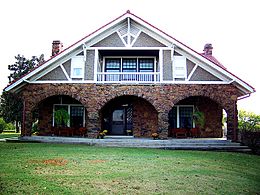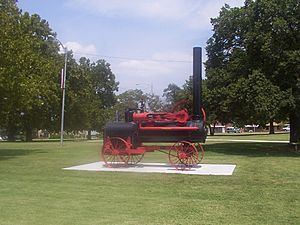Pawnee, Oklahoma facts for kids
Quick facts for kids
Pawnee, Oklahoma
Paári
|
|
|---|---|

Pawnee Bill Ranch and Museum
|
|
| Motto(s):
"Where The West Remains"
|
|

Location of Pawnee, Oklahoma
|
|
| Country | United States |
| State | Oklahoma |
| County | Pawnee |
| Area | |
| • Total | 3.62 sq mi (9.38 km2) |
| • Land | 3.14 sq mi (8.13 km2) |
| • Water | 0.48 sq mi (1.25 km2) |
| Elevation | 873 ft (266 m) |
| Population
(2020)
|
|
| • Total | 1,936 |
| • Density | 616.76/sq mi (238.14/km2) |
| Time zone | UTC-6 (Central (CST)) |
| • Summer (DST) | UTC-5 (CDT) |
| ZIP code |
74058
|
| Area code(s) | 539/918 |
| FIPS code | 40-57650 |
| GNIS feature ID | 2411389 |
Pawnee is a city in Oklahoma, United States. It is also the main town, or county seat, of Pawnee County. The city is located northeast of Stillwater. You can find it where U.S. Route 64 and State Highway 18 meet.
The city got its name from the Pawnee tribe. This tribe moved to the area between 1873 and 1875. In 2020, about 1,936 people lived in Pawnee.
Contents
A Look Back: Pawnee's History
Early Days and the Pawnee Tribe
The Pawnee Agency and Pawnee Boarding School were set up after the Pawnee tribe arrived in 1875. The Pawnee Agency became a post office in 1876.
Opening to Settlers
On September 16, 1893, the area was opened to new settlers. This happened during the Cherokee Outlet Opening. The town, first called Townsite Number Thirteen, was chosen as the temporary county seat. The post office changed its name to Pawnee in October 1893. The town officially became a city on April 16, 1894. In 1895, the people built a stone courthouse for the county.
Railroads and Growth
Between 1900 and 1902, the Eastern Oklahoma Railway built a train line through Pawnee. This railway later became part of the Atchison, Topeka and Santa Fe Railway. In 1902, another railway, the Arkansas Valley and Western Railway, also built a line through the city. These railroads helped Pawnee grow as a place where farmers could trade their goods.
When Oklahoma became a state in 1907, Pawnee had 1,943 people. Since then, the number of people living in Pawnee has mostly gone down. The 2020 Census showed a population of 1,936.
Building During Hard Times
Pawnee kept developing even during the Great Depression. This was mostly thanks to government projects that created jobs. A hospital for several Native American tribes opened in 1931. A new school building opened in 1932. Also in 1932, a new county courthouse was built. The government also created Pawnee Lake, a reservoir, two miles north of town. This lake has 5.4 miles of shoreline and is 310 acres big.
Where is Pawnee?
Pawnee is a city with a total area of about 2.2 square miles (5.7 square kilometers). All of this area is land.
Pawnee's Population Over Time
| Historical population | |||
|---|---|---|---|
| Census | Pop. | %± | |
| 1900 | 1,464 | — | |
| 1910 | 2,161 | 47.6% | |
| 1920 | 2,418 | 11.9% | |
| 1930 | 2,562 | 6.0% | |
| 1940 | 2,742 | 7.0% | |
| 1950 | 2,861 | 4.3% | |
| 1960 | 2,303 | −19.5% | |
| 1970 | 2,443 | 6.1% | |
| 1980 | 1,688 | −30.9% | |
| 1990 | 2,197 | 30.2% | |
| 2000 | 2,230 | 1.5% | |
| 2010 | 2,196 | −1.5% | |
| 2020 | 1,936 | −11.8% | |
| U.S. Decennial Census | |||
In 2000, there were 2,230 people living in Pawnee. There were 878 households, and 581 families. The average household had about 2.44 people. The average family had about 3.08 people.
About 27.4% of the population was under 18 years old. About 18.2% were 65 years or older. The average age in the city was 39 years.
The 2016 Earthquake
On September 3, 2016, a strong earthquake hit near Pawnee. It had a magnitude of 5.8. This earthquake caused cracks and small damage to buildings. It was the strongest earthquake ever recorded in Oklahoma. It was even stronger than the 5.7 magnitude earthquake near Prague, Oklahoma in 2011. Scientists believe this earthquake was caused by injecting wastewater deep underground. This wastewater is a byproduct of a process called fracking, which is used to get oil from shale rock.
Fun Things to See and Do in Pawnee
- Pawnee Indian Veterans Homecoming and Powwow: This special event happens every year around the 4th of July. It celebrates Native American veterans and their culture.
- Meridian Technology Center: This center helps students learn important job skills.
- Pawnee High School: The local high school for students in the area.
- Home of the Pawnee People: Pawnee is an important center for the Pawnee people and their government.
- Pawnee Lake: This lake is great for boating, fishing, and camping. It also has a 9-hole golf course and horse facilities nearby.
- Pawnee Bill Historical Museum: Here you can learn about Pawnee Bill, his Wild West Shows, and the Pawnee tribe.
- Oklahoma Steam and Gas Engine Show: This yearly event shows off old steam engines and gas engines. It happens during the first weekend of May.
- Pawnee Bill Memorial Rodeo: This rodeo often includes a Western Heritage Week, a horse and mule sale, a car show, and youth rodeos.
- Pawnee Bill’s Original Wild West Show: A show that brings back the excitement of the old Wild West.
- Dick Tracy Wall Mural: A large painting on a wall featuring the famous detective, Dick Tracy.
- Pawnee County Historical Society Museum & Dick Tracy Headquarters: This museum keeps the history of Pawnee alive. It has items from old ghost towns, Pawnee Tribe history, and lots of Dick Tracy items.
Important Historic Places
Eight of the 12 historic sites in Pawnee County that are listed on the National Register of Historic Places (NRHP) are located right in Pawnee. The NRHP is a list of places that are important to American history. These sites include:
- Arkansas Valley National Bank
- Blue Hawk Peak Ranch, also known as the Pawnee Bill Ranch
- Corliss Steam Engine, found at the Pawnee County Fairgrounds
- Pawnee Agency and Boarding School Historic District
- Pawnee Armory
- Pawnee County Courthouse
- Pawnee Indian Agency
- Pawnee Municipal Swimming Pool and Bathhouse
Famous People from Pawnee
Many interesting people have connections to Pawnee:
- Kenneth D. Bailey: A brave soldier who received the Medal of Honor.
- Bill Bredde: A football player who played for Oklahoma State University and the Chicago Cardinals.
- Carter Camp: A Native American activist.
- Ernest E. Evans: A Navy officer who received the Medal of Honor for his actions in World War II.
- Chester Gould: The cartoonist who created the famous comic strip character, Dick Tracy.
- Saginaw Grant: An actor, dancer, and speaker.
- Clyde LeForce: A football player chosen by the Detroit Lions in the 1945 NFL Draft.
- Gordon W. Lillie (also known as Pawnee Bill): A famous presenter of Wild West Shows.
- May Lillie: A performer in Wild West Shows, known for her sharpshooting and horse riding skills.
- John J. Mathews: A well-known historian.
- Neil E. McNeil: A judge in Pawnee who later became an Associate Justice of the Oklahoma Supreme Court.
- Steve Ripley: A musician and leader of the band The Tractors.
- Jennie Stevenson (also known as Little Britches): A female bandit who briefly escaped from custody in Pawnee in 1895.
- Della Warrior: Born in Pawnee, she was the first and only female chair of the Otoe-Missouria Tribe. She also led the Institute of American Indian Arts.
- Moses J. "Chief" YellowHorse: The first full-blooded Native American professional baseball player, playing for the Pittsburgh Pirates.
See also
 In Spanish: Pawnee (Oklahoma) para niños
In Spanish: Pawnee (Oklahoma) para niños


